Visible Light-Responsive Photocatalysts
SHARP Photocatalyst Business wins iF Design Award, Professional Concept
What are photocatalysts?
Photocatalysts are materials that are highly oxidative when exposed to light and are used to chemically break down toxic substances and odor components with which they come into contact. Years of experience in semiconductor device development have equipped Sharp with a solid foundation of process technology, while years of experience in MFP toner development and production have made it into an expert in powder pulverization and dispersion. In 2015, Sharp leveraged these two realms of expertise into developing a unique photocatalytic material.
Effects
Antiviral
Antibacterial
Deodorization
Antifouling
Antifungal
Anti-allergenic
Key Characteristics
The primary ingredient in Sharp’s photocatalytic material is tungsten oxide. Compared with titanium oxide, which was the standard photocatalytic material used up to that point, Sharp’s photocatalytic material reacts to a wider spectrum of light, thereby producing highly oxidative effects when exposed not only to sunlight, which includes ultraviolet light, but also to fluorescent light, LEDs, and other indoor lighting. Moreover, when combined with platinum nanoparticles as a promoter, an even higher level of performance is achieved.

Effective both outdoors and inside

Mechanism of Action
When the photocatalyst absorbs light, it reacts with the water and oxygen in the air to produce reactive oxygen species (O₂⁻ and ·OH). The strong oxidizing power of these reactive oxygen species breaks apart the chemical bonds within odors and other substances with which they come into contact. The odor components and other substances return to the air as water and carbon dioxide.

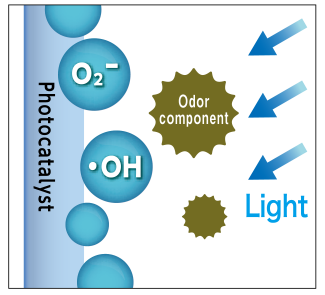
When the photocatalyst absorbs light, it produces reactive oxygen species (O₂⁻ and ·OH).
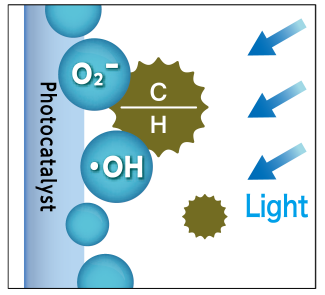
The reactive oxygen species break apart the chemical bonds within odors and other substances coming into contact with the photocatalyst.
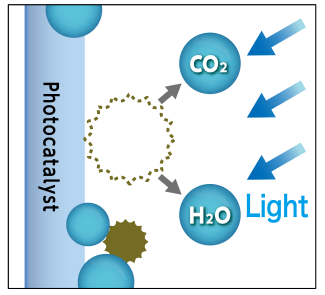
The odor components and other substances return to the air as water (H₂O) and carbon dioxide (CO₂).
Main Demonstration Testing Data
Antiviral
The infectivity titer of virus*1 was reduced by the effect of photocatalyst.
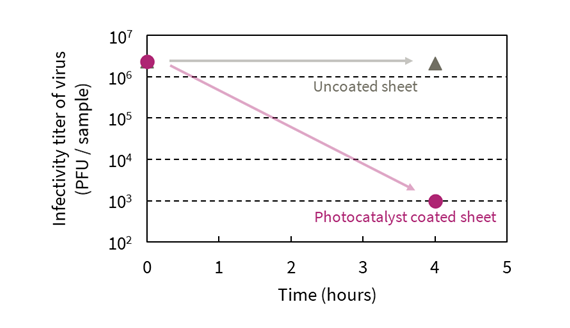
- Test result
- The infectivity titer of virus *1 was reduced by 99.96% *2 under fluorescent light 500 lx (wavelength 380 nm or less was cut) in 4 hours.
- Test lab
- Kanagawa Institute of Industrial Science and Technology
- Test report No.
- KISTEC03-016A02
- Test method
- With reference to JIS R 1756:2020 (film cover method)
- Test virus
- A kind of adhered bacteriophage
(An alternative to viruses that infect animal cells)
- *1A value that represents the infectivity of a virus to infect cells
- *2Converted value by Sharp based on the test result
Antibacterial
Number of viable bacteria was reduced by the effect of photocatalyst.
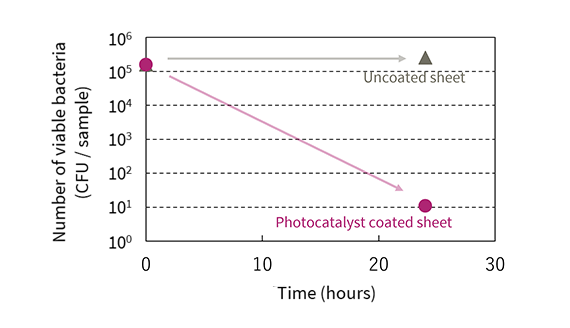
- Test result
- Number of viable bacteria was reduced by 99.99% or more * to an undetectable level under fluorescent light 1,000 lx (wavelength 380 nm or less was cut) in 24 hours.
- Test lab
- Japan Food Research Laboratories
- Test Report No.
- 15064805001-0101
- Test method
- With reference to JIS R 1752:2013
- Test bacteria:
- A kind of adhered bacterium
- *Converted value by Sharp based on the test result
Deodorization
Odor components were reduced by the effect of photocatalyst.
| Odor components | Odor type | Exposure time | Reduction rate |
|---|---|---|---|
| Isovaleric acid (3-methylbutanoic acid) |
Sweat, foot odor, etc. | 3 hours | 99.7% |
| Methyl mercaptan | Rotten onions, garbage, etc. | 3 hours | 82.0% |
| Nonenal | Old person smell, etc. | 1 hour | 99.6% |
| Ammonia | Body odor, toilet odors, pet urine, etc. | 1 hour | 99.8% |
| Acetic acid | Cigarette odor, sweat, spoiled milk, etc. | 1 hour | 99.2% |
| Acetaldehyde | Cigarette odor, body odor, etc. (Found in building material and furniture paint, adhesives, etc.) |
1 hour | 99.7% |
| Toluene | Paint thinner, etc. (Found in building material and furniture paint, adhesives, etc.) |
3 hour | 98.9% |
| Formaldehyde | New car smell, etc. (Found in building material and furniture paint, adhesives, etc.) |
1 hour | 99.8% |
- ・Test lab
- Sharp
- ・Test method
- With reference to JIS R 1757:2013
A prescribed concentration of different gases along with the photocatalyst are enclosed within sampling bags (0.5 L). The bags are exposed to 10,000 lx of white LED for the indicated period of time. The gas concentrations are then measured via gas chromatography for the nonenal and a gas-detecting tube for the other gases. The results are compared with the initial gas concentrations and the reduction rate calculated.
Antifouling
The organic dye was decolorized by the effect of photocatalyst.
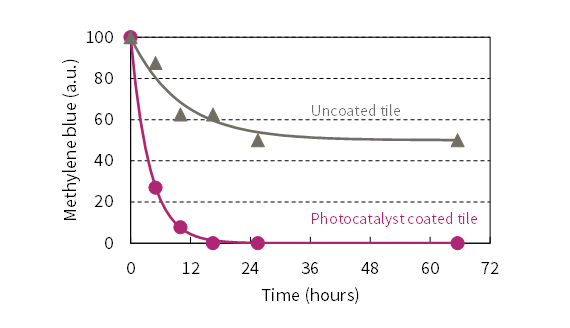
| Time | 0h | 5h | 10h | 16h |
|---|---|---|---|---|
| State of fouling |  |
 |
 |
 |
- Test result
- Methylene blue was decolorized to an undetectable level under white LED 2,500 lx in 16 hours.
- Test lab
- Investigated by Sharp
- Test method
- Measure the color level of methylene blue by the amount of reflected light each time after dropping and drying 20μL of methylene blue solution (100 μmol / L) on the photocatalyst coated / uncoated porous tile and illuminating with white LED 2,5000 lx.
Antifungal
The mold growth was prevented by the effect of photocatalyst.
| Without irradiation | With irradiation |
|---|---|
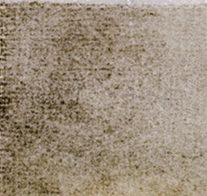 |
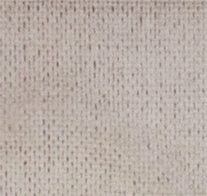 |
- Test result
- Under fluorescent light 500 lx (wavelength 380 nm or less was cut), no mold growth was detected by visual observation even after 4 weeks.
- Test lab
- Hygiene & Microbiology Research Center
- Test report No.
- 2018D-BT-418
- Test method
- With reference to JIS Z 2911:2010, JIS R 1705:2016
- Test mold
- A kind of mold spore
Anti-allergenic
Activity of allergic substance was reduced by the effect of photocatalyst.

- Test result
- Activity of allergic substance was reduced by 96% or more * to an undetectable level under white LED 1,000 lx in 24 hours.
- Test lab
- Biostir Inc.
- Test report No.
- 14-an-SHP-5
- Test method
- After light irradiation to the mixed solution of photocatalyst and Derf1, the activity of allergic substance was measured by ELISA method.
- Test allergens
- A kind of adhered allergens derived from mite droppings and carcasses
- * Converted value by Sharp based on the test result
Complete decomposition
Acetaldehyde was decomposed into carbon dioxide by the effect of photocatalyst.
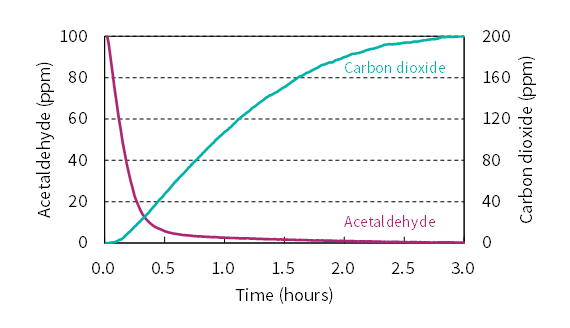
- Test result
- Acetaldehyde was completely decomposed into carbon dioxide in 3 hours.
- Test lab
- Investigated by Sharp
- Test method
- With reference to JIS R 1757:2013
Longevity
The effect of photocatalyst lasts long after repetitive use.
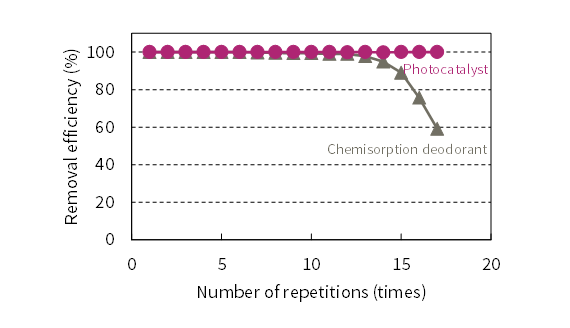
- Test result
- The reduction rate of acetaldehyde never deteriorated after repeating the measurement 17 times.
- Test lab
- Investigated by Sharp
- Test method
- Measure the acetaldehyde concentration with a gas detector tube after enclosing 400 ppm of acetaldehyde and the same amount of photocatalyst or chemisorption deodorant in a sampling bag (1L) and illuminating with white LED 1,000 lx for 2.5 hours.
Repeat the above procedure as 1 trial.
Safety
All requisite safety standards for product certification by the SIAA (Society of International sustaining growth for Antimicrobial Articles) and PIAJ (Photocatalysis Industry Association of Japan) have been met.
| Test item | Test results | Test lab |
|---|---|---|
| Acute oral toxicity test | Out of category | Frey-Tox (Germany) |
| Skin irritation test | Negative | Frey-Tox (Germany) |
| Mutagenicity test (Ames test) |
Negative | NISSEI BILIS (Japan) |
| Skin sensitization test | Negative | Fraunhofer (Germany) |
- Some photographs and illustrations on this website are conceptual representations.

